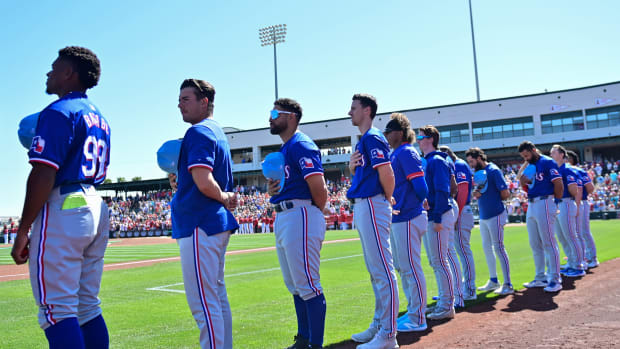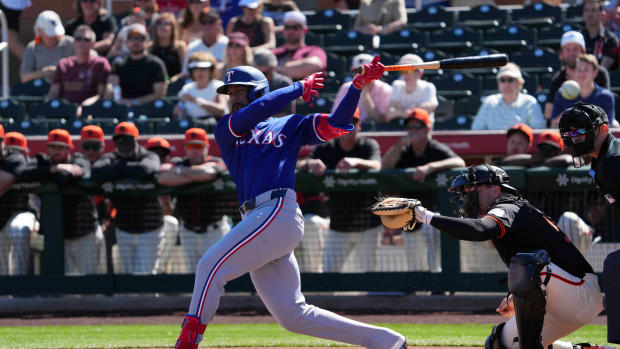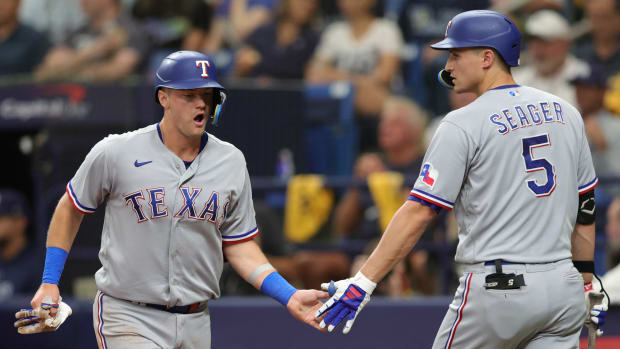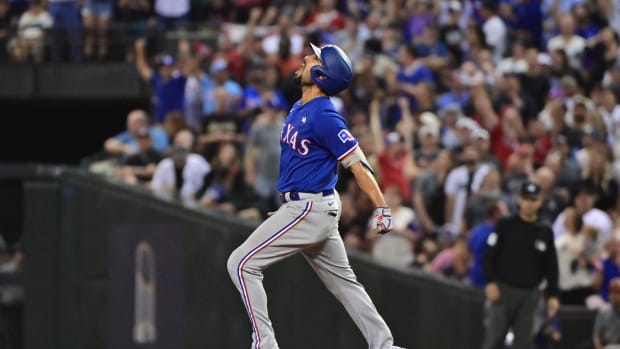After Spending Over Half a Billion Dollars, Do The Rangers Have an Encore?
Before the 2021 season came to an end, Texas Rangers leadership repeatedly said the club was going to be active and aggressive in free agency this winter. That picture became a bit more clear when president of baseball operations Jon Daniels, general manager Chris Young and manager Chris Woodward addressed the media on Oct. 6 and said ownership had given their stamp of approval to pay "market dollars" for "top-tier" free agents.
Fast forward to now, and the Rangers have spent more in one offseason than any other team ever has—all in roughly 24 hours, no less. First, the Rangers landed one of the big five shortstops, securing Marcus Semien with a seven-year, $175 million contract. Less than an hour later, they added depth to their outfield by bringing Kole Calhoun in on a one-year, $5.2 million deal with a club option for 2023. Later in the evening, Texas bolstered its rotation with a high-floor addition, signing Jon Gray to a four-year, $56 million contract.
The Rangers weren't done. Starting pitching and outfield were still on their list of priorities, along with...another shortstop?
Sources confirmed with SI's InsideTheRangers.com on Monday that the club was making a push for Seager and Irving native Trevor Story, in hopes of luring one of them to pair with Semien as a dynamic duo in the middle infield. Come Monday afternoon, the Rangers obliterated expectations, landing Seager with a 10-year, $325 million deal—the most expensive contract in franchise history.
Add all of that up, and the Rangers committed $561.2 million to four free agents. It was a great day for Rangers fans (except for the "ownership is cheap" sect of the fan base). The Rangers now have star power coupled with a farm system that is trending upward, and is expected to begin producing some of its most exciting prospects over the next couple years (Josh Jung, Jack Leiter, Cole Winn and more).
The Rangers still may not be in position to win in 2022, but the future just got a whole lot brighter. Both Young and Daniels have indicated any moves this winter were not about winning in the short-term. Rather, it's all part of a multiyear plan to build a contender in 2023 and beyond.
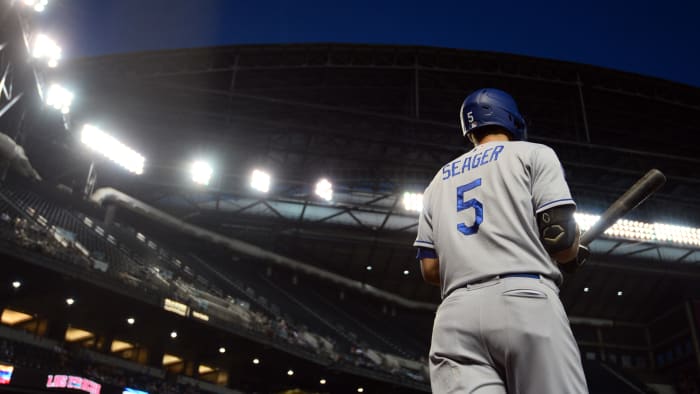
Seager's 10-year, $325 million contract is the largest in Rangers history, surpassing Álex Rodríguez's 10-year, $252 million mega-deal in 2000.
Joe Camporeale-USA TODAY Sports
What Happens Now?
There isn't much time to take a breath. At least, not yet.
Tuesday is the tender deadline, meaning the Rangers have to tender contracts to their pre-arbitration and arbitration-eligible players by 7:00 p.m. CST tonight. There aren't any obvious "non-tender" candidates on the Rangers roster, but it's still a deadline that deserves attention.
The Rangers only have one vacant spot on their 40-man roster, and have four players to add to it (after physicals are completed), hopefully before the impending lockout begins when the calendar rolls from Dec. 1 to Dec. 2. Players could be designated for assignment, non-tendered or possibly even traded.
So, don't stay away from your phones for too long.
What Happens Next?
Next? Like, the Rangers could spend more money?
*insert Jack Nicholson nodding GIF*
Sources indicate the Rangers are still in the market for another starting pitcher or potentially an outfielder. The two names that are still tied to the Rangers are Japan's Seiya Suzuki and Dallas native Clayton Kershaw. However, sources tell SI's InsideTheRangers.com that any more Rangers free agent signings aren't likely to happen until after the expected lockout is over.
For now, that still leaves Suzuki and Kershaw as possibilities for the Rangers. Suzuki's 30-day window to negotiate a contract with a Major League team began on Nov. 22, and that time period—like the rest of big league transactions—would be frozen when a lockout begins on Dec. 2. That gives Suzuki 20 days left to negotiate a deal after a new Collective Bargaining Agreement is signed.
As for Kershaw, he doesn't seem to be in a rush to sign a contract. A lockout gives the Rangers and Los Angeles Dodgers—the two most likely suitors for Kershaw—some time to see how his forearm reacts to the platelet-rich plasma injection, and what his status would be for the 2022 season.
If things don't work out with either Suzuki or Kershaw, there are still plenty of free agents that the Rangers can afford. Even after committing to more than half a billion dollars, the Rangers' current 2022 payroll wouldn't crack the top 10 in Major League Baseball.
Prior to the four free-agent signings becoming official, the only guaranteed contracts on the books belong to José Leclerc and Kohei Arihara ($8.85 million). The Rangers are still on the hook for $19.58 million from the Elvis Andrus and Rougned Odor trades. The Rangers' arbitration class is projected to make $8.7 million, and set aside roughly $13 million for an extensive crop of pre-arbitration players that fill out the remainder of the roster.
Now take that total number ($50.1 million), and add the AAVs from the four free-agent signings. That's a total of $126.8 million. This is obviously a rough number since we don't know the breakdown of the Seager, Semien or Gray contracts, but it's a good barometer.
In October, Daniels said their budget would be "consistent with the market and fan base of this size". Dallas-Fort Worth is a top-five sports market, and a payroll of $125-130 million would put the Rangers right in the middle of the league.
Based off of what Daniels and Young have said—and they've held true to their word thus far—there is still room to add more.
What Happens With Isiah Kiner-Falefa?
The "Hawaiian Hustle" has been on a positional carousel over the past few seasons—pretty much ever since he broke into the big leagues with the Rangers.
Kiner-Falefa came up as a utility infielder and later began the transition to catcher in 2018. The opposite happened in 2019, going from a full-time catcher back to a utility infield role. In 2020, Kiner-Falefa won the everyday job at third base out of both versions of spring training, and subsequently won a Gold Glove at the position. Then in 2021, after the Rangers parted ways with fan favorite Elvis Andrus, Kiner-Falefa reached his goal of becoming an everyday shortstop in the big leagues.
Now Kiner-Falefa will be on the move again. There are three likely options (in no particular order):
1) Kiner-Falefa is the Opening Day third baseman for the Rangers. The last thing the club wants to do is rush their top position-player prospect to the big leagues. After slashing .326/.398/.592/.990 with 19 home runs and 61 RBI in 78 total games between Double A and Triple A, Josh Jung has indicated he is ready for the challenge of the big leagues.
However, it was still Jung's first full season as a professional, and a stress fracture in his foot prevented him from playing until mid-June. The Rangers front office may play it safe and decide to have Jung start the 2022 season at Triple-A Round Rock, then call him up by June of all goes well. The Rangers would need a third baseman, and Kiner-Falefa would be the obvious first choice.
Of course, there is another Seager still available in the free agent market, and I think he plays third base.
2) Kiner-Falefa becomes the Rangers' super-utility player, and it's a role where he could really thrive. He plays elite-level defense at either middle-infield spot, and won a Gold Glove at the hot corner in 2020. Kiner-Falefa has exceptional bat-to-ball skills, and hits for a decent average. He's a very good baserunner and a great guy in the clubhouse. Most championship teams have an Isiah Kiner-Falefa-type on their team.
If Josh Jung is deemed ready and thrives at the hot corner, or if the Rangers sign Corey's brother Kyle, they could have one of the best utility players in baseball.
3) The Rangers trade him. It won't be an easy decision, and the clubhouse would definitely miss him. However, if the Rangers want to give him a chance to play everyday and are committed to reserving third base for Jung, trading him might be the best way to provide that opportunity.
Sources confirm with SI's InsideTheRangers.com that the New York Yankees have contacted the Rangers about the possibility of acquiring Kiner-Falefa. Antony Volpe, the Yankees' top prospect, is expected to be ready to play shortstop in the big leagues in about two years, which is the same amount of club control remaining over Kiner-Falefa.
The match makes sense. However, don't anticipate the Rangers just giving Kiner-Falefa away. If they trade him, the Rangers will look for either someone who can contribute to the big league squad or increasing the depth of an already deep farm system. Remember, the two clubs recently connected on the Joey Gallo trade, so the Rangers know the Yankees farm system pretty well.
Make sure to like SI's 'Inside The Rangers' on Facebook
